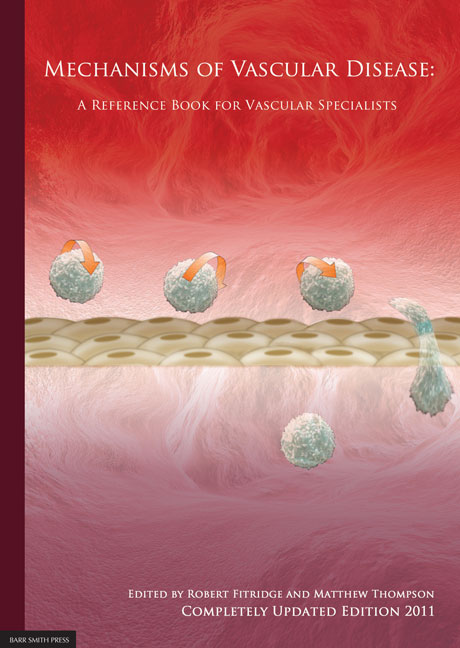Book contents
- Frontmatter
- Contents
- List of Contributors
- Detailed Contents
- Acknowledgements
- Abbreviation List
- 1 Endothelium
- 2 Vascular smooth muscle structure and function
- 3 Atherosclerosis
- 4 Mechanisms of plaque rupture
- 5 Current and emerging therapies in atheroprotection
- 6 Molecular approaches to revascularisation in peripheral vascular disease
- 7 Biology of restenosis and targets for intervention
- 8 Vascular arterial haemodynamics
- 9 Physiological Haemostasis
- 10 Hypercoagulable States
- 11 Platelets in the pathogenesis of vascular disease and their role as a therapeutic target
- 12 Pathogenesis of aortic aneurysms
- 13 Pharmacological treatment of aneurysms
- 14 Pathophysiology of Aortic dissection and connective tissue disorders
- 15 Biomarkers in vascular disease
- 16 Pathophysiology and principles of management of vasculitis and Raynaud's phenomenon
- 17 SIRS, sepsis and multiorgan failure
- 18 Pathophysiology of reperfusion injury
- 19 Compartment syndromes
- 20 Pathophysiology of pain
- 21 Post-amputation pain
- 22 Treatment of neuropathic pain
- 23 Principles of wound healing
- 24 Pathophysiology and principles of varicose veins
- 25 Chronic venous insufficiency and leg ulceration: Principles and vascular biology
- 26 Pathophysiology and principles of management of the diabetic foot
- 27 Lymphoedema – Principles, genetics and pathophysiology
- 28 Graft materials past and future
- 29 Pathophysiology of vascular graft infections
- Index
26 - Pathophysiology and principles of management of the diabetic foot
Published online by Cambridge University Press: 05 June 2012
- Frontmatter
- Contents
- List of Contributors
- Detailed Contents
- Acknowledgements
- Abbreviation List
- 1 Endothelium
- 2 Vascular smooth muscle structure and function
- 3 Atherosclerosis
- 4 Mechanisms of plaque rupture
- 5 Current and emerging therapies in atheroprotection
- 6 Molecular approaches to revascularisation in peripheral vascular disease
- 7 Biology of restenosis and targets for intervention
- 8 Vascular arterial haemodynamics
- 9 Physiological Haemostasis
- 10 Hypercoagulable States
- 11 Platelets in the pathogenesis of vascular disease and their role as a therapeutic target
- 12 Pathogenesis of aortic aneurysms
- 13 Pharmacological treatment of aneurysms
- 14 Pathophysiology of Aortic dissection and connective tissue disorders
- 15 Biomarkers in vascular disease
- 16 Pathophysiology and principles of management of vasculitis and Raynaud's phenomenon
- 17 SIRS, sepsis and multiorgan failure
- 18 Pathophysiology of reperfusion injury
- 19 Compartment syndromes
- 20 Pathophysiology of pain
- 21 Post-amputation pain
- 22 Treatment of neuropathic pain
- 23 Principles of wound healing
- 24 Pathophysiology and principles of varicose veins
- 25 Chronic venous insufficiency and leg ulceration: Principles and vascular biology
- 26 Pathophysiology and principles of management of the diabetic foot
- 27 Lymphoedema – Principles, genetics and pathophysiology
- 28 Graft materials past and future
- 29 Pathophysiology of vascular graft infections
- Index
Summary
INTRODUCTION
The incidence of diabetes continues to grow at a staggering pace. The United States' Centers for Disease Control and Prevention estimate that 23.6 million people or 7.8% of the U.S. Population has diabetes, with 1.6 million new cases being diagnosed each year. These figures are even more astonishing when one considers worldwide estimates. Close to 4 million deaths in the 20–79 year old age group may be attributed to diabetes in 2010, accounting for 6.8% of global all-cause mortality in this age group. The number of people with diabetes worldwide is expected to reach 366 million people by 2030, more than double the estimated 177 million people affected with the disease in 2000. The increased disease prevalence is accompanied by an increase in associated comorbidities. The literature estimates that patients with diabetes have nearly a 25% lifetime risk of developing a foot ulcer with more than 50% of these ulcers becoming infected and requiring hospitalization. In fact, at least 20% of all diabetes-related hospital admissions are due to diabetic foot ulcers. Associated with foot ulcers and infection is the incidence of amputation. It has been conservatively reported that, worldwide, a major amputation takes place every 30 seconds with over 2500 limbs lost per day. At least 60% of all non-traumatic lower extremity amputations are related to complications of diabetes. People with diabetes who have had one amputation have a 68% risk of having another in the next 5 years and have a 50% mortality rate in the 5 years following the initial amputation.
- Type
- Chapter
- Information
- Mechanisms of Vascular DiseaseA Reference Book for Vascular Specialists, pp. 475 - 496Publisher: The University of Adelaide PressPrint publication year: 2011
- 5
- Cited by



